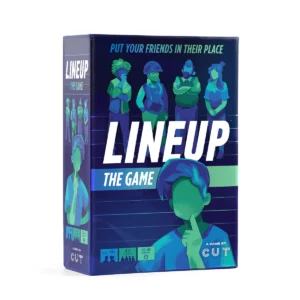

My critical play is on “Lineup: The Game,” created by Cut, a popular channel on YouTube that produces videos featuring ordinary people, friends, and couples playing social deduction or getting-to-know-you games. Last year, they released a commercially-available version of their popular game Lineup. The game is marketed to ages 14+, which also reflects the demographic of their viewers on their YouTube channel. I played the game with the NSFW expansion of the game marketed for ages 18+, which may indicate a skew towards audiences older than 14. The game is targeted towards both friend groups and for groups of strangers, since the game on YouTube is also played by both kinds of groups. Being marketable towards both groups is important for a social game since not every consumer has a large enough friend group to play with consistently that could justify buying the game. The theming of the game is very minimal, using color to distinguish player whiteboards and to distinguish card deck types.
The cards prompt players to secretly write answers on their whiteboard in the format of a quantifiable number. For example, a prompt might be “What’s the smallest amount of money for which you’d eat a tarantula?” which can be answered with a monetary value that is easily comparable to other answers. Limiting answers to quantifiable values creates a mysterious dynamic that makes players probe further into other players’ answers, since the answers themselves seldom speak for themselves. Prompting players to discuss reasoning for their answers encourages discussion and argument that is essential to a social game of this type. This contributes to an aesthetic of fellowship between players, regardless of how well they know each other.
Having the ability to choose which deck to draw from allows players some agency in how ‘deep’ they want to get. I appreciate how my group of friends could get straight into some very revealing and personal questions, while a different group has the equally valid choice to play with more innocuous questions. This relieves some pressure and allows for a ramp-up in how personal questions become over the course of the game, again contributing to fellowship between players.
Players earn points by making a guess about how they think other players’ answers relate to one another. For instance, I might guess that Player A gave an answer that’s less than Player B, who then had an answer smaller than Player C. Guessing relationships between answers awards points. For groups of close friends, this mechanic creates a dynamic of competition over “who knows each other the best.” For groups of acquaintances or strangers, this creates a dynamic of “who can suss out vibes the best.” I would argue that this mechanic works better in groups of close friends in the sense that it generates more intense and rich gameplay, though there is still value in the mechanic for groups of strangers since it generates further conversation. Both kinds of dynamics contribute to an aesthetic of discovery as each players learns more about others’ funny stories and backgrounds.
In my play through the game with a group of close friends, many of us forwent the points system altogether and decided to play through two times around our circle of players. After a night of playing two other decently long games and a few rounds of drinks, we felt like the point system wasn’t important because we weren’t interested in competition—we only cared about laughing and learning about each other. I could say that it may be the fault of the game for not generating enough of a competitive dynamic to motivate us to keep the points system, but instead I appreciate how easy it is to mod the game into a non-zero sum game without sacrificing the rich gameplay. The game works either way, and I believe a well-designed game can easily be iterated upon. It’s important for a party game to allow for continuous, unending gameplay as long as the players are interested in it.



